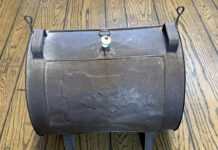If you have ever taken a small child to a roller skating party, sooner or later some energetic teenagers corral the troops and organize them into a long line to do the limbo.
While two kids hold onto either end of a long stick, each child tries to skate under the stick while bending backwards. The first time, the stick is about 4 feet off the ground and usually every kid gets underneath.
After each child goes under once, the stick is lowered about 6 inches and everyone goes again. With every 6 inches the stick is dropped, a couple kids topple over backwards as they try to lean backwards but skate forward.
If you touch the floor going under, you are out.
Frequently the kids who “dropped” out first were clowning around a bit as they tried to clear the bar. But after about three passes, the remaining kids get serious.
While the short ones initially have some advantage, when that stick is about 30 inches off the ground, you can see each skater slowing a bit as their turn approaches and they calculate their strategy to get under that stick and be able to stand up on the other side.
Some lean strait back. Bigger kids lean a little to the side and spread their arms wide to get greater balance. The tiniest go for the fast duck.
Dairy limbo line
Dairy farms across the country are in that limbo line. Each month as the Class III spirals downward, we approach that stick and try to figure out how to get under and still be able to stand up on the other side.
While we are caught up and focused on the constant strategizing, we really have to be careful how the seemingly smaller decisions we make to get under the stick each month will impact the long-term health and viability of the business.
During the last quarter of 2008, maybe 5 percent of dairies were covering their total costs of production when the Class III plus the producer price differential averaged $15.85 per cwt.
Currently, 2009 prices are not even covering variable costs. On average, every 100 cows milked came up $10,500 short in January. Ouch.
Once existing cash reserves are used up, alternative sources of cash must be found if the dairy is going to stay in business.
Short term, we usually look at procuring or increasing an existing line of credit.
Typically a line of credit is used to cover short term cash shortfalls that are usually repaid within a year.
If today’s milk futures reflect what is likely to happen this year, farms will lose money every month. Just maybe not as much in the last half.
So realistically, debt taken on to manage cash flow this year is not going to be repaid this year. When markets turn around, the farms left standing will likely need several years to repay this debt.
Protect equity
The farm’s net worth (total assets less total debts) is in a state of flux. What is happening to asset values now is why we must be conservative when valuing cattle and land on balance sheets.
Total debt should be less than 40 percent of the value of the farm’s assets. As asset values drop, the farm’s percentage of debt increases.
Farms at 40 percent debt or higher will not be able to borrow much, if any more money to weather tight cash flows.
Monitor debt
Now is the time to push some numbers. Current ratio (current assets divided by current liabilities), scheduled debt payment per cow, debt to asset ratio and debt per cow are very good measures for monitoring debt for the dairy business.
See the 15 Measures of Dairy Farm Competitiveness at http://dairy.osu.edu for details about calculating and using these measures.
Control debt
Right now I would focus on the debt to asset ratio to monitor the overall farm business, and debt per cow to monitor repayment capacity if you are considering taking on additional debt.
If these are less than 40 percent and $2,500 per cow respectively, then calculate scheduled annual debt payment per cow with a goal of keeping it at $500 per cow or less.
While the cows are not going to be able to pay back additional debt this year if current conditions continue, you have to protect their ability to repay debt when the market returns.
In most cases, a total debt of $2,500 per cow with annual repayment of principal and interest totaling less than $500 per cow is doable.
However, each farm has to push these numbers for themselves. A few can handle higher levels; others will not be able to handle these levels.
If you are borrowing additional operating dollars (rather than a collateralized term loan) “schedule” them for your per cow figure over the time period you think it will take to repay the note if it is greater than one year.
Front-line attack
Controlling costs has been the front-line attack for dealing with pitiful milk prices. While it absolutely should be done, it is not enough to make up the cash flow shortfall.
As cash reserves are depleted, it is critical borrowing be done carefully so the farm’s equity and future profitability is not endangered.
Some farms are facing very challenging situations and will have to consider if they even should try to borrow additional money or exit the dairy industry and preserve their equity.
Tool
We do have an excellent tool in the FINPACK farm financial analysis and projection software to help generate the information to help make these decisions.
We will discuss additional tools and options next week.












